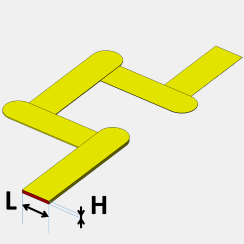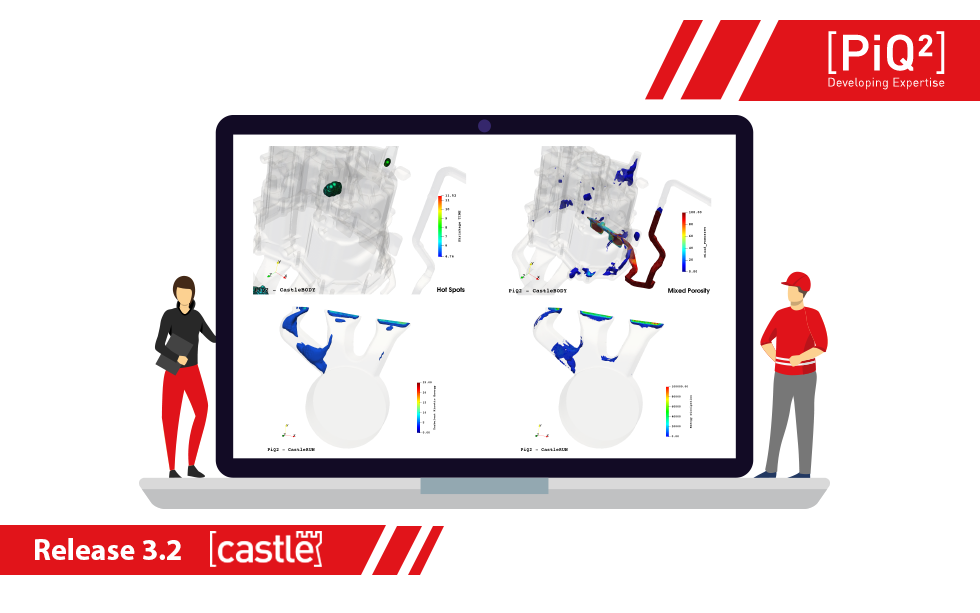Castle V3.2, the new and updated version of Castle, was recently released by the PiQ² team and is now available.
PiQ² has always been very attentive to the needs of its customers, who are considered to all intents and purposes a real development team, always generous with important suggestions and stimulating requests. Once again, therefore, many of the improvements result from a close collaboration between the PiQ² staff and all Castle users.
The improvements concern the entire Castle suite, but CastleBODY is the application that has received the most impactful updates.
CastleBODY
Work has been done on optimizing the computing environment to reduce and standardize simulation times through the introduction of the System Memory Optimization (SyMO). This function improves PC performance by optimizing the use of hardware resources (RAM and CPU), thus avoiding the bottleneck of the Windows operating system on intensive computing.

In addition, to save disk space and make it easier to store and share results, the Reduce HD Space option now allows you to reduce the size of simulations by 20-30% without losing any detail in the result.

In order to reduce calculation times and facilitate mesh setup, improvements have been made to the 3D mesh interface. The new features make the user’s job easier, allowing to load parameters from previously created meshes. Functions have also been introduced that allow the reduction of the mesh dimensions and consequently the calculation times for geometries with very thin walls.
From the point of view of CastleBODY’s operability, we updated and strengthened the interrupted SIM recovery system, thus increasing the possibility for the user to autonomously resume the calculation of simulations interrupted for external causes (blackout, running out of disk space, etc.).
From a more foundry process-related point of view, a tool for managing pre-filling simulations, i.e. when a partial pre-filling of the cavity at low speed occurs, is now available in the CastleBODY interface. This injection setting is sometimes used in the production of bottom-fed thick-walled components. In the event of a delayed start of the fast shot, the percentage of filling in the slow shot is calculated and an indication of the corresponding filling mode is provided.

The alloy database has been further expanded by introducing several proprietary alloys which find application in the production of structural Giga Castings. In the same way, the database of tool steels has been updated and now integrates the most common commercial codes of tool steels with specific properties.
The visualization of the results has been improved and simplified and, as in the past, the results of simulations carried out with previous versions will still be viewable in a simple and immediate way.
From the point of view of the results and their interpretation, CastleBODY V3.2 introduces an important upgrade in the visualization and calculation of the air entrained during filling: the calculation of the Air Porosity criterion has been revised and improved, making an even more accurate analysis possible.
This also makes it a lot easier to compare different simulations. The air volume is in fact now recalculated based on the pressure available in the 2nd or 3rd phase and made independent of the unpredictable pressure peaks that develop in the last filling steps due to water hammer effect.
Furthermore, using the new entrapped-air filter, it is now possible to manually measure the volume of air trapped in specific areas of the casting.
From the Solidification point of view, two new criteria are now available for an even more precise and detailed evaluation of the defects: Hot Spots, for the identification of areas where a delayed solidification occurs, and Mixed Porosity, which takes into account the presence of areas where the risk of air and shrinkage porosity coexists.


CastleRUN
What we have just illustrated for CastleBODY regarding the improvements made to the meshing interface and the enhancement of the computing environment also applies to CastleRUN.
From the point of view of CastleRUN results, two new variables are now available, both indicating the presence of dangerous high turbulence regions in the runners: Turbulent_Kinetic_Energy and Energy_Dissipation.


CastleMIND
The CastleMIND DCM press database has been expanded and updated with the inclusion of a considerable number of new machines and manufacturers and now also includes data from several GIGA presses. It also benefits, like CastleBODY, from the expansion of the casting alloys and tool materials databases.
In addition, we introduced some marginal but significant improvements: for example, the venting system definition interface was simplified and made easier for the user to understand.



The PiQ² team improved the calculation algorithms and corrected several minor bugs to make the Castle experience even more rewarding.

